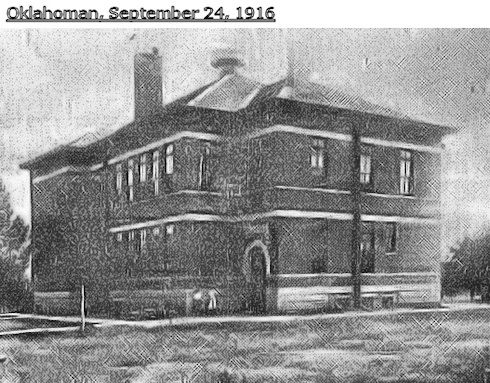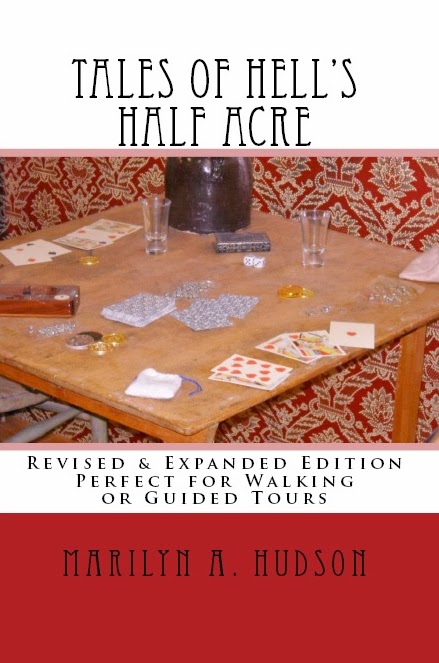.jpg)
The post WWI years were wild, frenzied, and tended to flaunt social conventions in response, no doubt, to the combustion of war, the loss of life, and the shattering of a generation's illusions of innocence.
When a 47 year old millionaire, leader in politics at the state level and on speaking terms with a presidential candidate, dies after being shot by a woman not his wife, well heads turned.
Late in the evening of November 20, 1920, young Clara Barton Smith, who shared connecting suites with Jake L. Hamon at the Randol Hotel in Ardmore, Oklahoma, was greeted by an inebriated Hamon. He seemed disturbed by her going out 'automobiling' with someone. The story becomes a little murky as to details at this point, but apparently they went to the suite of rooms where the argument continued. At one point he allegedly choked her and lifted a chair to hit her (this action seen in profile by a witness on the street below) . A gun materialized and she either threatened to use it and it went off accidentally or she intentionally withdrew it intent on stopping her older 'companion' in mid-assault. Which version depended on whose side a person was on in the matter.
Wounded in the liver, Hamon walked approximately five blocks to a nearby hospital for treatment. There he gave the statement he had been shot by Smith. One heard him denounce the woman with a statement suggesting she had intentionally tried to kill him and others heard him say no such thing. He was on record as saying it had been accidental.
Local police, despite the victim's assurances that it was an accident seemed determined to hunt down the young woman and arrest her for attempted murder and then later after Hamon died, for murder. Hamon's lawyer would report in court that his client had told him to write a check for $5000 to the girl and send her away to safety.
Witnesses saw Hamon kiss the girl in the hospital and would testify that there seemed nothing but fondness between the two.
Yet, local and state law seemed abnormally determined to hunt her down as a murderess. She successfully disappeared, as instructed by the victim, and was actively tracked for nearly a month all around the country. Her luggage was confiscated and searched in Kansas City. Leads and tips followed and dead ends exhausted. Crack reporters from around the country swept into the state, swept out and located information the police seemed unable to find. The woman had been in Mexico. Soon, she was meeting with local police and lawyers to ensure a safe and protected return to the 'scene of the crime.'
The case, as is often the situation, brought into focus a growing trend in American society. Relationships were often fluid and did not adhere to a previous generations more strict Victorian mores about marriage, sex, and what constituted a family. Although married, the wife spent most of her time in Chicago and not in Ardmore. A young son, Jake Jr. was 18 at the time of the shooting and his sister Olive Belle only 11. Reading between the lines in some stories there was the tantalizing scent of scandal kept unacknowledged and hidden while being in plain sight. The social clothing of the railroad emperor Hamon were distinctly see through. Everyone 'knew' about the affair of the man with the pretty young girl he had first met when she was 17 tending shop in Ardmore. She was his companion and secretary but he was obviously jealous of her seeing other men and shared (as they did at the Randol Hotel) adjoining rooms.
The scent was sometimes even fetid as it was found in 1917 she had married Frank Louis Hamon, the nephew of Jake L. Hamon, in El Paso and three months later divorcing him. The second wife of Frank muddied the tabloid waters when she hinted that the millionaire had paid his nephew to marry the girl and given him a monthly salary for the deed. Frank Hamon denied she had been bribed to provide the girl with a name she could use to travel without question with the millionaire uncle.
In 1922, the notorious woman was acquitted of murder by a jury who had listened to a great deal of testimony. Included was that of the widow of the dead man who said it had been an accident. The lawyers were skilled but it does seem that the Oklahoma delegation were bull dog determined to ignore the faults of the man and create a callous killer in Smith.
As Oklahoma columnist Edith C. Johnson noted in an essay Smith was apparently just a young girl who had made a series of poor choices in her life. The image emerges from Johnson's profile of vain, perhaps silly, girl who fond it easier to enjoy the pleasures her looks might bring than to safeguard her innocence and acquire a finer caliber of man. For Johnson, she might have had a good, solid man taking care of her rather than being a punching bag for an older and meaner man. Johnson's interviews with Smith apparently uncovered an elephant in the room of 1920's domestic reality. Hamon was a controlling man with abusive tendencies ranging possibly from emotional to physical (the chair raised to hit Smith as an example).
In 1920, however, men were men and women were...less. Men with money, status, political connections and the ability to benefit individual and state coffers were definitely more valued than silly young women who became companion mistresses to such men. Oklahoma was on the verge of a decade to be noted by corruption, racism as the KKK took positions in government, socialism's growth in society and in every level of society power-mad deals as well as vast economic growth. The escape of the post WWI era would led to increased social problems, a frenzied focus on money, and a tendency to shake off the restrictions of the past with no idea of what to put in its place.
In terms of out of the state press coverage the case was definitely notorious. It was dramatic, shocking, and titillating. In fact, there appears more detailed information on the case in the papers of other cities than in major news sources of Oklahoma City.
Is it, however, the most notorious? We will have to see about that...
Some sources:
Johnson, Edith C. "The Might-Have-Been In Clara Smith's Career". Oklahoman (Dec. 29, 1920)6.
Stewart, Ray. " Spectacular Murder Case Brought Swarm of Writers to State." Oklahoman (Sept.8, 1966)8.
"Hamon Death A Mystery." Los Angeles Times (Nov. 27, 1920)11.
"Girl Near Collapse." Los Angeles Times (March 16, 1921)1.
"Hamon's Widow Testifies." New York Times (March 15, 1921)6.


















.jpg)






















